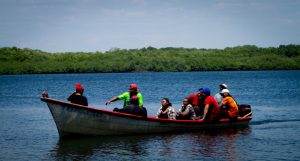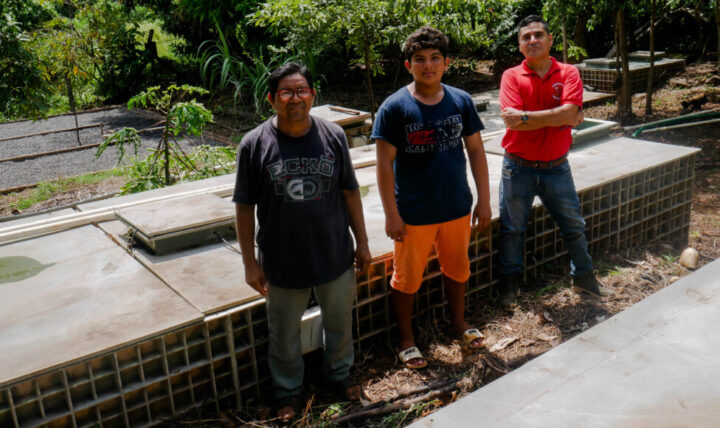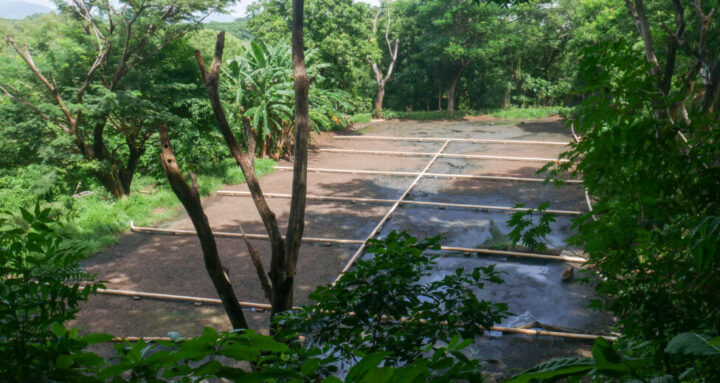
A group of “curileros” ride in a boat in the bay of Jiquilisco, in the Pacific Ocean off the Salvadoran coast, during the daily task of searching for “curiles”, a locally prized mollusk. Two municipalities bordering the bay, Jiquilisco and Puerto El Triunfo, are working to keep a treatment plant that processes wastewater from these towns active, in order to avoid contaminating this important wetland and protect the health of local families and visitors. CREDIT: Edgardo Ayala / IPS
By Edgardo Ayala
CHIRILAGUA, El Salvador , Oct 25 2023 – Insufficient wastewater treatment systems in El Salvador have taken a toll on the environment and the health of the population for decades, but some municipalities are putting more attention on processing their liquid waste.
Various reports warned as early as 2014 that in El Salvador, a country of 6.7 million people, only 8.52 percent of wastewater receives some form of treatment, and the picture has not changed much since then.”My job is to provide the proper maintenance so that the plant works well and we make sure that the environment is not polluted.” — Eduardo Ortega
It is not surprising, then, that only 12 percent of the rivers have good quality water and that dozens of people die each year from diarrhea: this year, as of Sept. 30, 63 people had died from this cause, of a total of more than 164,000 reported cases.
Wastewater includes what is generated in domestic activities, such as the use of toilets, sinks, washbasins and laundry. Wastewater is also produced by industry, but due to its characteristics it requires more complex treatment.
With international assistance
Few municipalities and communities have their own wastewater treatment systems, in some cases created as collective efforts that included their own funds as well as financing from international institutions and from the central government.
“My job is to provide the proper maintenance so that the plant works well and we make sure that the environment is not polluted,” Eduardo Ortega, who runs one of the few treatment plants located in eastern El Salvador, told IPS.
Ortega works in maintenance in the plant located next to La Española, a rural settlement in the municipality of Chirilagua, which borders the Pacific Ocean, in the south of the department of San Miguel.
La Española, a village of 40 houses, was built with Spanish aid funds for 40 fishing families affected by Hurricane Mitch, which left a trail of death and destruction in Central America in October 1998.
The housing project, financed by the government of the southern Spanish region of Andalucía, included a basic sanitation system that is unusual in rural areas: a sewage network that transports wastewater, including human waste, to the treatment plant.
A nearby similar initiative of 278 houses built for 1,500 people, called Flores de Andalucía, in the vicinity of Chirilagua as well, was also financed by humanitarian aid from the regional government of Andalucia.
There are currently 196 “ordinary” treatment plants in the country, in other words, plants that treat wastewater from domestic activities.
Of these, 90 are private, 78 are public and 17 are community-run, among other categories, according to the Ministry of the Environment and Natural Resources.

Eduardo Ortega (L), in charge of the treatment plant located near Chirilagua, in the department of Usulután in eastern El Salvador, and Edwin Guzmán (R), head of the municipality’s Environmental Unit, are mainly responsible for ensuring that the liquid waste treatment plant is operating at 100 percent. The station was built with financial aid from Spain as part of a housing project to benefit victims of Hurricane Mitch, which devastated large areas in Central America in October 1998. CREDIT: Edgardo Ayala / IPS
Bacteria and gravel filters
The process begins with a hydraulic structure that removes sand and other small particles which, before passing into a tank, are filtered through a screen, Edwin Guzmán, head of the environmental unit of the local government of Chirilagua, a municipality of 25,000 people, including the local capital and outlying villages, told IPS.
The liquid then runs into another tank containing bacteria that eliminate the organic matter that has been dissolved into particles before reaching the tank.
After this, the waste passes to the biofiltration areas: rectangular ponds two meters deep, filled with layers of volcanic rock and gravel.
Finally, everything goes to another pond with “percolator” filters, which contain more bacteria to eliminate any remaining organic matter.
“This treated water will not contaminate the San Román river, which is about three kilometers away,” Guzmán said.
He added: “If this treatment plant were not here, there would be terrible pollution of the river, which is one of the few in the area that always has a good flow of water.”
And if the river were polluted, it would also affect the waters of the Pacific, where it flows into from this small Central American country that only has coasts on that ocean.

A view of part of the infrastructure of the treatment plant set up next to Jardines de Andalucía, the second housing project built in 2003 mostly with Spanish aid near the Salvadoran municipality of Chirilagua, on the coastal strip of the eastern department of Usulután. CREDIT: Edgardo Ayala / IPS
A cleaner sea
The larger Flores de Andalucía plant also receives sewage from El Cuco, a beach located about two kilometers to the south, visited by tourists drawn by its kilometers of gray sandy beaches and the gentle waves of the sea.
The inhabitants of El Cuco have always been dedicated to fishing, but there are also businesses, small hostels and restaurants, whose wastewater no longer goes directly into the sea.
The wastewater is collected in a tank and, fueled by a gasoline engine, is pumped uphill through a pipeline to the plant, its final destination.
“Before, all that water went straight to the sea,” José Henríquez, one of the plant’s operators, told IPS.
“It is important to treat the water, because otherwise we are contaminating ourselves,” said Henríquez, while cleaning the plant’s pipelines.
But despite this initiative, it is estimated that only 60 percent of the wastewater from El Cuco and surrounding areas is treated, as there are people and businesses that, for some reason, bypass the regulations and continue the old practice of dumping their wastewater on the beach.
Moreover, the municipalities near Chirilagua do not have treatment plants and, consequently, much of their waste is discharged into the rivers, which carry it to the sea.
Official figures show that 61.5 percent of Salvadoran households throw gray water, from washing clothes, hands, dishes, etc., into the street or outdoors, 33 percent dispose of it through sewage systems and 2.3 percent through septic tanks. The remaining 3.1 percent discharge their gray water into rivers or use other means.

El Cuco beach, on the Pacific coast of El Salvador, is a community whose wastewater is pumped through a pipeline uphill to the treatment plant located in Jardines de Andalucía, near Chirilagua, to prevent contamination generated by the villlage’s shops, homes, restaurants and hostels from reaching the sea. CREDIT: Edgardo Ayala / IPS
A bay without pollution
Further west on the Salvadoran coast is Jiquilisco Bay, the country’s main wetland, a place of exuberant natural beauty covering more than 600,000 hectares, home to numerous marine-coastal plant and animal species.
The municipality of Puerto El Triunfo, population 20,000, is located on the edge of the bay’s estuary in the south of the department of Usulután. A treatment plant that has been processing the municipality’s wastewater since the end of 2009 is located nearby.
The Puerto El Triunfo plant was also partially financed by aid from Spain, which contributed approximately 50 percent of the cost of the work, which totaled 660,000 dollars.
The rest of the investment came from the municipal and central governments.
“The water used to be dumped untreated into the mangrove swamp and into the bay; now it is discharged treated, cleaner,” Evelio Álvarez, in charge of the Environmental Unit of the Puerto El Triunfo municipal government, told IPS.
Álvarez said that in 2010, due to financial problems, the municipality could no longer afford to run the plant and ceded control to the government’s National Aqueduct and Sewer Administration, which has managed it ever since.
The facility also processes liquid waste from Jiquilisco, a municipality of some 50,000 inhabitants located about eight kilometers north of Puerto El Triunfo, from where the wastewater is pumped down to the station.
In the past, the waste from Jiquilisco went directly into the El Paso River, which flows into the bay.

Only 8.52 percent of the wastewater generated in El Salvador receives some type of treatment, and much of the waste is dumped untreated into rivers and streams, which end up depositing it in important wetlands in the country, contaminating ecosystems and affecting people’s health. CREDIT: Edgardo Ayala / IPS
“Most of the families make their living from fishing, and all that pollution was going raw into the mangroves,” agro-ecologist Etelvina Pineda, head of the environmental unit of the Jiquilisco municipal government, told IPS.
From the mangrove swamp and its web of canals the pollution spread to the lowlands bordering the bay, and as a result the homemade wells that supplied the coastal communities in the area had high concentrations of Escherichia coli, a bacterium present in human feces.
In addition, in the mangroves, “we ended up contaminating the mollusks, crustaceans and all the marine fauna that live there, through feces and heavy materials,” said Pineda.
As a result, people got sick from eating improperly cooked seafood. The pollution also decimated the marine fauna, a source of income for local families.
However, as in Chirilagua, Pineda pointed out that the pollution has not been stopped 100 percent.
She stressed that this would require a broader and more comprehensive effort, including the other four municipalities with an impact on the bay: Usulután, San Dionisio, Concepción Batres and Jucuarán.
In addition to the lack of financial resources to carry out such a program, Pineda argued that there is an absence of political will on the part of local governments and the central government, which she said are not committed to solving the environmental problems of this area or the country as a whole.